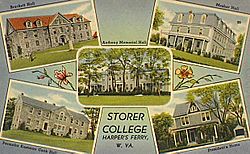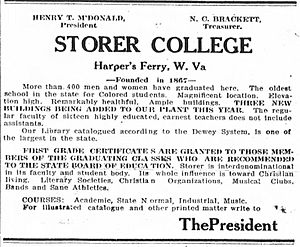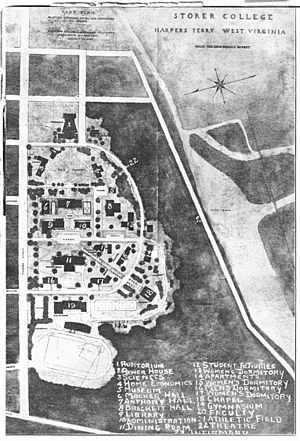Storer College facts for kids

Storer College postcard (1940)
|
|
|
Former names
|
Storer Normal School |
|---|---|
| Active | 1867–1955 |
| Location |
,
,
39°19′25.64″N 77°44′7.49″W / 39.3237889°N 77.7354139°W |
Storer College was a special school in Harpers Ferry, West Virginia. It was open from 1867 to 1955. It was known as a historically black college, meaning it was mainly for Black American students.
Storer College was very important for Black Americans. It was located in the town where Frederick Douglass said the "end of American slavery began." This school was unique because its focus changed over time. Sometimes, white students even studied there alongside Black students. This was unusual because, at that time, laws in many states kept Black and white students separate.
In the 1900s, Storer College became a key place for protests against unfair laws called Jim Crow laws. These laws treated Black people differently. The protests eventually led to the creation of the NAACP and the Civil Rights Movement. The first meeting in America of the Niagara Movement, which was a group that came before the NAACP, happened at Storer in 1906.
John Brown's Fort, a famous symbol of the fight to end slavery, was even located on the Storer campus from 1909 to 1968. It was used as the college museum. Today, the former campus is part of the Harpers Ferry National Historical Park.
Contents
What Was Storer College?
Storer College was a unique school that helped many Black Americans get an education. It was often called a "normal school" because it mainly trained teachers for elementary schools. It also offered high school-level classes.
The school was special because it accepted students "without distinction of race or color." This was very rare for its time. It also accepted both male and female students, which was also unusual back then.
Where Was Storer College Located?
Storer College was in a very beautiful spot. It was on a hilltop overlooking where the Shenandoah River and Potomac River meet. The amazing Blue Ridge Mountains were also visible. People said the view was one of the most scenic for any college.
How Did Storer College Begin?
Storer College started very simply in 1865. It was a one-room elementary school. It was supported by a group called the New England Free Baptists and the Freedmen's Bureau. The first students were 19 children who had been enslaved. They needed to learn basic skills like reading, writing, and math.
It's hard to imagine today how groundbreaking it was to open a school for African Americans right after the Civil War. Just a few years earlier, teaching enslaved people was against the law in Virginia. Even free Black people were not allowed to be educated by law. But once slavery ended, there was a huge desire for education.
A Special Gift and a New School
A man named John Storer gave a gift that helped start the college. He wanted a school in the Southern states where young people could be educated "without distinction of race or color." Even though it was called a college, it mostly trained high school students to become teachers for many years.
The Free Baptists considered Storer College their biggest success. The U.S. Congress even gave the school four buildings that used to be part of the Harpers Ferry Armory. Over time, the school grew. It added a traditional high school, job training classes, and then junior college classes. Finally, it offered four-year college degrees.
Until 1891, Storer was the only college in West Virginia that accepted non-white students.
Why Harpers Ferry?
In 1865, Reverend Nathan Cook Brackett chose Harpers Ferry as the base for his teaching efforts. He was working for the Freewill Baptist Home Mission Society. The town had been damaged during the Civil War. But a strong, empty building called Lockwood House was available. Reverend Brackett and his family started teaching there.
They taught reading, writing, and math to children who had been enslaved. Sometimes, their parents joined the classes too. But the children often learned faster than their parents!
From this small start, Storer slowly grew. It became a normal school, then a college prep school, then a two-year college, and finally a four-year college. Many formerly enslaved people came to Storer because they wanted to learn new skills. They wanted to build a new life after slavery.
This school was part of a bigger effort by groups in the North and the government's Freedmen's Bureau. They wanted to set up schools to educate the millions of African Americans who were freed by the Thirteenth Amendment to the United States Constitution.
Getting a State Charter
The few teachers at Storer couldn't meet the huge need for education. By 1867, about 16 teachers were trying to educate 2,500 students. Reverend Brackett realized he needed to train African-American teachers.
In 1867, John Storer, a kind person from Maine, heard about the school. He offered a $10,000 grant to the Free Will Baptists to start a college. He wanted it to be open to both sexes and all races. His family later added more money for a library.
The money was raised, and Storer received its state charter in March 1868. The idea of educating students "without distinction of race or color" was strongly debated. But it passed! The school was allowed to train teachers for "colored schools." "Storer College, Normal Department" opened in October 1868. Reverend Brackett was the principal until 1896.
Government Support
On December 15, 1868, President Andrew Johnson signed a bill. This bill gave Storer College four strong, empty buildings that had been used by workers at the Armory. These buildings became the main part of the campus. The college also received the land these buildings were on. The college was officially dedicated on December 22, 1869.
What Did Students Learn at Storer?
When it first started, and for much of its history, Storer College didn't offer what we think of as a college degree today. Many colleges back then also taught high school-level classes. This was because many areas didn't have schools that prepared students for college.
Storer was the first school in West Virginia for Black students that was more than a simple one-room school. It taught reading, writing, and math because many Black people in the state didn't have access to this education. Storer's Preparatory Division helped students get ready for the Normal School, which required them to be able to read and write.
In 1938, Storer started offering classes that led to a four-year college degree.
Money for the College
The school charged very little for tuition, just $3 per quarter. Rooms were also cheap, so the main cost for students was food.
The Free Baptists put a lot of effort into supporting Storer College. In 1867, the West Virginia Legislature gave $10,000 to the school. This was the first time the state had given money for the education of Black people above elementary school.
Over the years, the state provided some money, but not always enough. Other groups, like the American Baptist Home Mission Society, also contributed.
Challenges and Local Feelings
Raising money was one thing, but dealing with local resistance was another. Some white residents in Harpers Ferry did not want a "colored school" there. Other mission schools had closed because of strong local opposition.
People in Harpers Ferry tried to shut down Storer College. They spread rumors and damaged property. They even asked the Legislature to take away Storer's charter. Threats from the Ku Klux Klan in the early years meant that teachers and students sometimes carried weapons for safety. In 1923, the Klan even marched past the college.
However, these efforts did not succeed in closing Storer. Over time, some local attitudes changed. By 1891, some people in Harpers Ferry even felt proud of the college.
Despite this, there were still challenges. In 1944, when Storer's first Black president, Richard Ishmael McKinney, arrived, he was met with a burning cross on his lawn. This was a symbol of hate.
Rules and Student Life
Students at Storer had many rules. They had to attend classes and study for an hour every morning. They couldn't drop or change classes easily. Students were not allowed to "loiter" on campus. They were also forbidden from leaving campus during the week. On weekends, they had to avoid dances and "walks in mixed company." Female students couldn't be out after dark or be seen alone with a man.
Students also did most of the work on campus. They cooked meals, cleaned buildings, and took care of the school farm.
Storer's Importance to Black Americans
For the 88 years it was open, Storer College was very important to Black Americans. It was seen as a place where they could get a good education and improve their lives.
Many Black tourists visited Harpers Ferry and Storer. There was even a hotel, the Hilltop House, built and run by a Black Storer graduate, Thomas Lovett, that welcomed them. In the summer, Storer rented out dormitory rooms to tourists.
Famous Events at Storer
Storer College was the site of several important events in African-American history.
Frederick Douglass's Speech (1881)
In 1881, Frederick Douglass, a famous speaker who had escaped slavery, gave a speech at Storer College. He was on Storer's Board of Trustees. He spoke about the abolitionist John Brown and tried to raise money for a special professorship for a Black man. Many people came from different states to hear him speak.
Niagara Movement Conference (1906)
The Niagara Movement was a group of important African-American thinkers. They wanted to fight against racial discrimination. Their leader was W. E. B. Du Bois. He disagreed with Booker T. Washington's idea of "accommodation" and pushed for social equality.
The second conference of the Niagara Movement, and the first one held in the U.S., took place at Storer in 1906. Attendees walked to John Brown's Fort, which was later moved to the campus. The group demanded voting rights, educational opportunities, fair treatment in courts, and recognition in unions and the military.
John Brown's Fort Moves to Campus (1909)
John Brown's Fort, which was the firehouse at the old Harpers Ferry Armory, was moved to the Storer campus in 1909. This was 50 years after John Brown's raid on Harpers Ferry. The Fort became the college museum. It was a popular place for Black Americans to visit. In 1968, after the college closed, the National Park Service moved it back closer to its original spot.
Why Did Storer College Close?
Storer College closed in 1955. Many people say it closed because state funding stopped after the 1954 Brown v. Board of Education ruling. This Supreme Court decision said that separating public schools by race was against the law.
While this ruling was a factor, Storer had faced money problems for a long time. Storer College charged no tuition. Its main money came from the Freewill Baptists. The state of West Virginia helped sometimes, but it wouldn't fully fund Storer because it was a religious school. Also, West Virginia's constitution didn't allow Black and white students to study together in publicly funded schools.
When the Brown v. Board of Education ruling came out, the West Virginia Legislature stopped its yearly money to Storer. They said it was no longer needed because Black students could now go to other state colleges. Storer had been losing money for ten years. Without the state's help, it couldn't survive. So, in June 1955, Storer College closed its doors.
What Is Storer's Legacy?
In 1962, the U.S. Congress gave money to the National Park Service to buy the remaining buildings on the Storer campus. These buildings became part of the Harpers Ferry National Historical Park.
In 1964, the college's movable items, like books, were given to Alderson-Broaddus College, another Baptist school. Storer's money for scholarships was combined with Virginia Union University, which is a historically Black college.
Since 1964, Virginia Union University considers Storer College graduates as its own alumni. Virginia Union University's library now holds many of Storer College's old books and records. Other records are kept at the Harpers Ferry National Historical Park library and West Virginia University.
The former campus is now part of the Harpers Ferry National Historical Park. The remaining college buildings are used by the National Park Service as a training center.
Every August, former students of Storer College gather in Harpers Ferry for a reunion.
Notable People from Storer College
Many important people studied or taught at Storer College:
- J. R. Clifford (1875) – The first African-American attorney from West Virginia.
- Hamilton Hatter (1878) – The first president of Bluefield Colored Institute.
- Coralie Franklin Cook (1880) – A professor at Howard University.
- John Francis Wheaton (1882) – The first African American member of the Minnesota State Legislature.
- Don Redman – A famous musician and arranger.
- Nnamdi Azikiwe (1926) – The first President of Nigeria. He studied at Storer from 1925–27.
- Ella P. Stewart – An African-American pharmacist.
Images for kids














